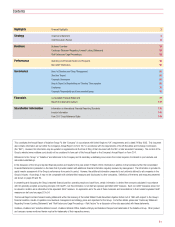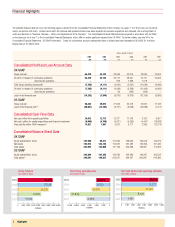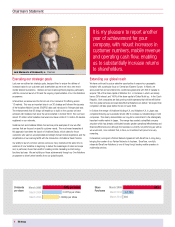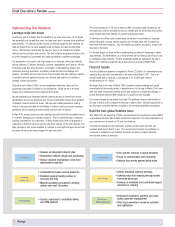Vodafone 2005 Annual Report Download - page 12
Download and view the complete annual report
Please find page 12 of the 2005 Vodafone annual report below. You can navigate through the pages in the report by either clicking on the pages listed below, or by using the keyword search tool below to find specific information within the annual report.
Business Overview
10 |Business
Contents
Page
Overview 10
Mobile Telecommunications 10
– Business strategy 10
– Local operations 10
Competition 10
Summary of Group mobile telecommunications businesses 11
Licences and network infrastructure 12
– Global services 13
One Vodafone 13
Products and services 13
Marketing and brand 15
Distribution 16
Multinational corporates 16
Research and development 16
– Regulation 17
Non-mobile Telecommunications 20
History and Development of the Company 20
Overview
Vodafone Group Plc is the world’s leading mobile telecommunications company, with a
significant presence in Europe, the United States and the Asia Pacific region through
the Company’s subsidiary undertakings, associated undertakings and investments. The
Group also has arrangements to market certain of its services in additional territories,
through “Partner Networks”, without the need for equity investment. The Group
provides a wide range of mobile telecommunications services, including voice and data
telecommunications. The Group also has a controlling interest in a non-mobile
telecommunications business in Germany.
The Company’s ordinary shares are listed on the London Stock Exchange and the
Company’s ADSs are listed on the New York Stock Exchange (“NYSE”). The Company
had a total market capitalisation of approximately £94 billion at 23 May 2005, making
it the third largest company in the Financial Times Stock Exchange 100 index, or FTSE
100, and the eleventh largest company in the world based on market capitalisation at
that date.
Mobile Telecommunications
Business strategy
Vodafone is at the centre of three enormously valuable markets – telecommunications,
infotainment and IT productivity. The Vodafone strategy is to mobilise these markets
and, through this process, grow voice and data service revenue. In doing this,
Vodafone is particularly seeking to leverage third generation (“3G”) mobile technology
to develop new, enhanced service offerings for consumers and business customers.
The Group’s strategic roadmap identifies six key goals:
•delight our customers;
•build the best global Vodafone team;
•leverage our global scale and scope;
•expand our market boundaries;
•be a responsible business; and,
•provide superior returns to shareholders.
Vodafone has built a global footprint of mobile operations and is leveraging this global
presence to provide cost and time to market advantages. The One Vodafone
programme is designed to leverage this scale by enabling solutions to be designed
once and deployed multiple times. Vodafone’s marketing proposition roadmap delivers
an increasingly seamless and unique range of services to targeted customer segments
on a multi-market basis, combining the benefits of global scale and scope with the
advantages of local market understanding and responsiveness.
Underpinning all aspects of Vodafone’s strategy is a focus on the unique power of
mobility. With nearly 155 million proportionate mobile customers at the end of the
financial year, and using the benefits of early experience in commercialising the next
generation of wireless access technologies, Vodafone is well positioned to continue to
lead in mobile service provision in developed and emerging markets.
Local operations
The Company has equity interests in 26 countries, through its subsidiary undertakings,
associated undertakings and investments. Partner Network arrangements extend to a
further 14 countries.
At 31 March 2005, based on the registered customers of mobile telecommunications
ventures in which it had ownership interests at that date, the Group had approximately
154.8 million customers, calculated on a proportionate basis in accordance with the
Group’s percentage interest in these ventures, and 431.8 million registered venture
customers. The table on the next page sets out a summary of the Company’s
worldwide mobile operations at 31 March 2005 and venture customer growth in the
year then ended (the “2005 financial year”).
Competition
The Group faces a high degree of competition in each of its geographic markets. It is
subject to indirect competition from providers of other telecommunications services in
the domestic markets in which it operates in addition to direct competition from
existing network operators of mobile telecommunications services and mobile virtual
network operators (“MVNOs”) who do not operate a mobile telecommunications
network. Competitive pressures have led to reductions in tariffs and continued focus
on customer acquisition and retention initiatives, both of which have assisted the
management of the level of customer churn.
The Group expects that competition will continue from existing operators as well as
from a number of new market entrants, including those arising following the award of
new 3G licences and MVNOs. The scope of this increased competition, and the impact
on the results of operations, is discussed further in “Risk Factors and Legal
Proceedings”.
A summary of the Group’s network operator competitors in its markets at 31 March
2005 is also provided in the following table.
























